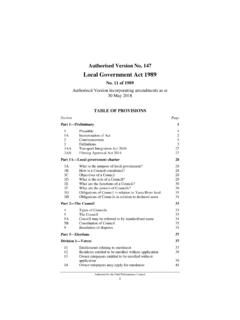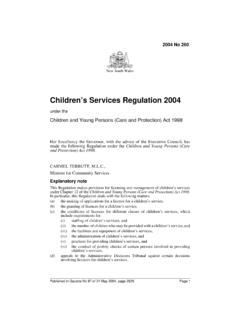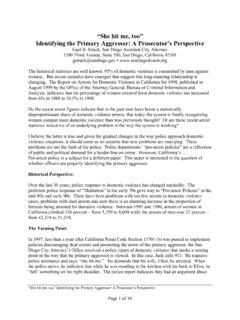Transcription of Responding to Historical Child Sexual Abuse: A Prosecution ...
1 Responding to Historical Child Sexual Abuse: A Prosecution perspective on current challenges and future directions Kara Shead*. Abstract The Prosecution of charges of Historical Child Sexual abuse routinely raises a range of complex legal and evidentiary issues in criminal law. There is often legal argument about the admissibility of evidence, lengthy legal directions to the jury and appeals following conviction. This is a constantly evolving area of the law and remains challenging for lawyers and other stakeholders in the criminal justice system.
2 This article examines some issues that commonly arise for prosecutors in handling such cases, including the separation of trials, the use of expert evidence, context evidence, concoction evidence and complaint evidence. Consideration is also given to the impact of the criminal justice setting on victims. The article is presented from the practical perspective of a Crown Prosecutor who works in prosecuting such cases. Through this prosecutorial lens, some proposals for reform are canvassed. Keywords: Child Sexual abuse Prosecution trial case management.
3 Evidence admissibility complaint delay tendency . concoction context cross-examination directions Introduction Like every Crown Prosecutor in New South Wales (NSW), I have been involved in numerous prosecutions alleging Historical Child Sexual abuse. These crimes are among the most serious prosecuted. The abuse of trust of a Child by a Sexual offender is unassailably heinous. Over the years, there have been a multitude of changes to the criminal law, many seeking to ameliorate the poor fit of our adversarial criminal justice system to deal with the *.
4 BA LLB (Hons) (Macq); Crown Prosecutor (NSW); member, Sexual Assault Review Committee (NSW). Correspondence: c/- Law Publishing Unit, Sydney Law School, Law Building F10, The University of Sydney NSW 2006, Australia. Disclaimer: The views expressed in this article represent those of the author alone. 56 current ISSUES IN CRIMINAL JUSTICE VOLUME 26 NUMBER 1. complexities of a Historical complaint, while at the same time preserving the fundamental rights of an accused. It is well accepted that Child Sexual abuse is an underreported crime (Fitzgerald 2006:2).
5 The sheer number of prosecutions that are dealt with indicates that it is not alarmist to refer to this type of offending conduct as an epidemic (Cowdery 2005:246), and a longstanding one at that. Academics and practitioners in Australia, England, Scotland and the United States (US) have devoted much energy and expertise to studies and evaluations of the criminal justice system to underpin reforms that are directed towards facilitating the Prosecution of such cases in a fairer For example, in the last 25 years there have been a range of reforms in Australia that allow the pre-recording of investigative interviews with children to be presented as their evidence-in-chief and to enable children to give evidence via closed-circuit television (CCTV)
6 , so that Child witnesses do not have to be in the courtroom or see the accused person (Cashmore 2002). A range of legislative changes have also been made in an attempt to facilitate the admissibility of children's evidence and control the way children are questioned during the trial (Caruso 2012). Child Sexual assault matters continue, however, to be very difficult to prosecute. Nevertheless, a large number of cases are prosecuted every year. In 2012, more than 300. offenders were brought before the NSW Supreme and District Courts charged with Sexual offences against children (NSW Bureau of Crime Statistics and Research (BOCSAR).)
7 2013:89). It seems likely that there will be further increases in complaints and prosecutions with the current national Royal Commission into Institutional Responses to Child Sexual Abuse, and the NSW Special Commission of Inquiry into matters relating to the Police investigation of certain Child Sexual abuse allegations in the Catholic Diocese of Maitland- Newcastle', and the consequent heightened media reporting and public awareness surrounding this issue. By and large, the criminal justice system deals with crimes that are immediately or soon discovered, investigated and ultimately prosecuted.
8 Child Sexual assault generally, and Historical Child Sexual assault in particular, are categories of crime that are, arguably, a poor fit for the traditional rules, practices and the very culture of the adversarial criminal justice system. Rules of evidence and the fact-finding processes struggle to recognise and respond appropriately to some of the key dimensions of Child Sexual offences. These include delay in disclosure and reporting that often characterises this type of crime, the lack of physical or other supporting evidence, and the complex dynamics that often underpin relationships between a Child victim and the alleged offender.
9 Moreover, judges and jurors who are called to adjudge these cases may lack the knowledge and experience to properly evaluate the evidence presented in the case (Shackel 2009a). Misunderstandings about the typical responses of victims of Child Sexual assault and the sequelae of such abuse may not be well understood by the fact-finders, but there is continuing resistance to the use of expert witnesses in such cases to help inform jurors and the court on such matters (Shackel 2009a). That is not to say that justice cannot be achieved within the current system.
10 It can be, and routinely is, achieved. But at what cost? Victims typically report a harrowing, lengthy and difficult process (Eastwood and Patton 2002; McWilliams et al 2014). Conviction rates are low (Fitzgerald, 2006; Flatman and Bagaric 1997/1998:5). Between 2006 and 2010 in NSW, an average of of the persons charged were found guilty of at least one Child sex 1. See, for example, in Australia: ACT Office of Director of Public Prosecutions and Australian Federal Police 2005; Burrows and Powell 2013, 2014; Cashmore and Trimboli 2005, 2006; Cossins 2009, 2010; Eastwood and Patton 2002; Fitzgerald 2006; Middleton et al 2014; WA Community Development and Justice Standing Committee 2008; Wundersitz 2003.
















